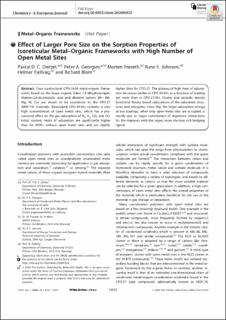| dc.contributor.author | Dietzel, Pascal D.C. | |
| dc.contributor.author | Georgiev, Peter A. | |
| dc.contributor.author | Frøseth, Morten | |
| dc.contributor.author | Johnsen, Rune E. | |
| dc.contributor.author | Fjellvåg, Helmer | |
| dc.contributor.author | Blom, Richard | |
| dc.date.accessioned | 2020-11-04T10:01:00Z | |
| dc.date.available | 2020-11-04T10:01:00Z | |
| dc.date.created | 2020-09-30T20:39:44Z | |
| dc.date.issued | 2020 | |
| dc.identifier.citation | Chemistry - A European Journal. 2020, 1-10. | en_US |
| dc.identifier.issn | 0947-6539 | |
| dc.identifier.uri | https://hdl.handle.net/11250/2686318 | |
| dc.description.abstract | Four isostructural CPO‐54‐M metal‐organic frameworks based on the larger organic linker 1,5‐dihydroxynaphthalene‐2,6‐dicarboxylic acid and divalent cations (M=Mn, Mg, Ni, Co) are shown to be isoreticular to the CPO‐27 (MOF‐74) materials. Desolvated CPO‐54‐Mn contains a very high concentration of open metal sites, which has a pronounced effect on the gas adsorption of N2, H2, CO2 and CO. Initial isosteric heats of adsorption are significantly higher than for MOFs without open metal sites and are slightly higher than for CPO‐27. The plateau of high heat of adsorption decreases earlier in CPO‐54‐Mn as a function of loading per mole than in CPO‐27‐Mn. Cluster and periodic density functional theory based calculations of the adsorbate structures and energetics show that the larger adsorption energy at low loadings, when only open metal sites are occupied, is mainly due to larger contribution of dispersive interactions for the materials with the larger, more electron rich bridging ligand. | en_US |
| dc.language.iso | eng | en_US |
| dc.publisher | Wiley | en_US |
| dc.rights | Navngivelse-Ikkekommersiell 4.0 Internasjonal | * |
| dc.rights.uri | http://creativecommons.org/licenses/by-nc/4.0/deed.no | * |
| dc.subject | open metal sites | en_US |
| dc.subject | molecular modeling | en_US |
| dc.subject | metal–organic frameworks | en_US |
| dc.subject | adsorption crystal structure | en_US |
| dc.title | Effect ofl larger pore size on the sorption properties of isoreticular metal–organic frameworks with high number of open metal sites | en_US |
| dc.type | Peer reviewed | en_US |
| dc.type | Journal article | en_US |
| dc.description.version | publishedVersion | en_US |
| dc.rights.holder | Copyright 2020 The Authors. Published by Wiley-VCH GmbH. This is an open access article under the terms of Creative Commons Attribution Non Commercial License, which permits use, distribution and reproduction in any medium, provided the original work is properly cited and is not us ed for commercial purposes. | en_US |
| dc.source.pagenumber | 13523-13531 | en_US |
| dc.source.volume | 26 | en_US |
| dc.source.journal | Chemistry - A European Journal | en_US |
| dc.identifier.doi | 10.1002/chem.202001825 | |
| dc.identifier.cristin | 1835869 | |
| cristin.ispublished | true | |
| cristin.fulltext | original | |
| cristin.qualitycode | 2 | |

